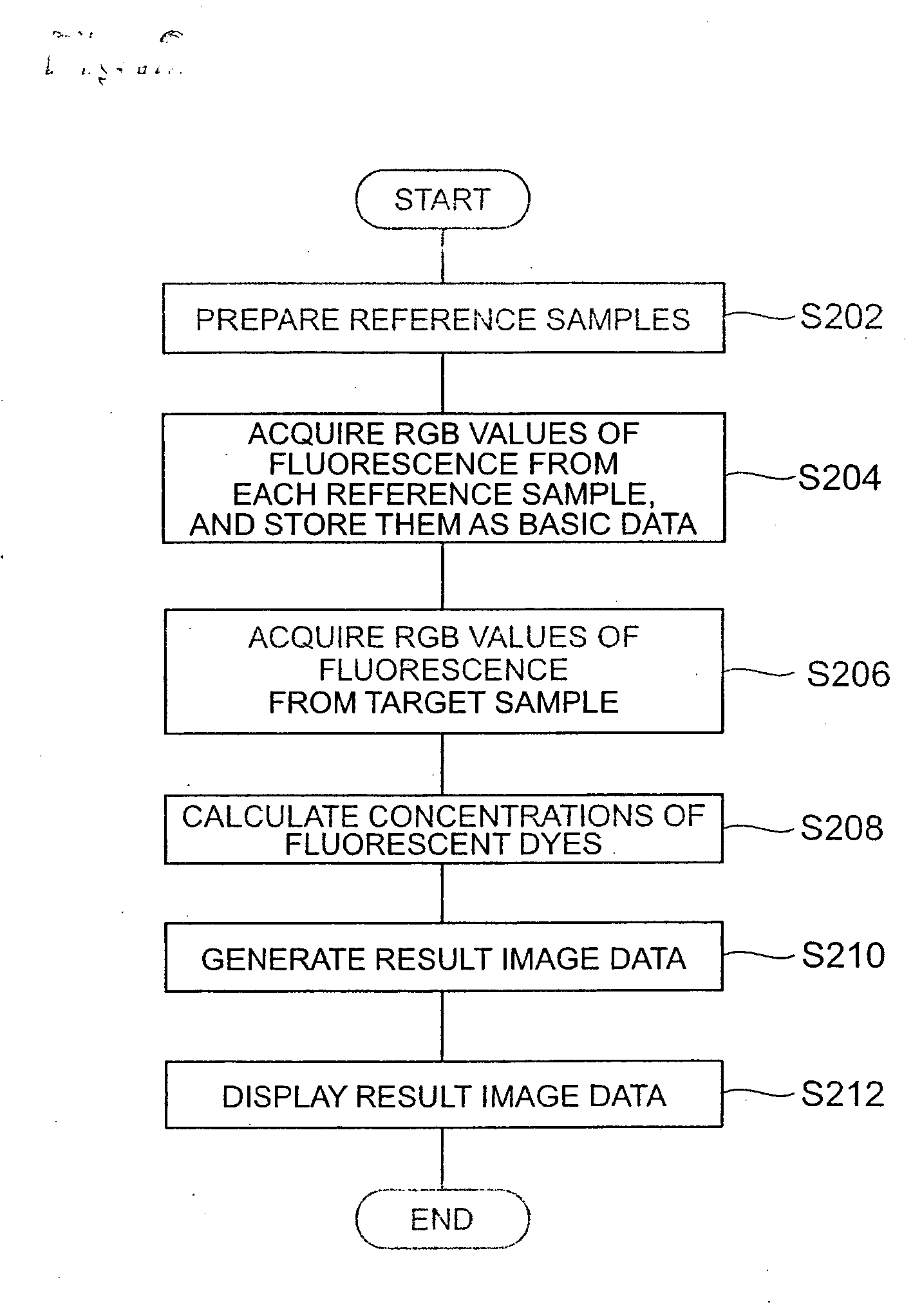Method and system for measuring the concentrations of fluorescent dyes
- Summary
- Abstract
- Description
- Claims
- Application Information
AI Technical Summary
Benefits of technology
Problems solved by technology
Method used
Image
Examples
first example
[0148] The present invention will be further described below with some examples. The Inventor conducted the measurement of fluorescent dyes by use of the measurement system 100 shown in FIG. 1 and in accordance with the method of the first embodiment. The multiband camera 30 used was the 3-CCD color camera ORCA-3CCD C7780 available from Hamamatsu Photonics K.K. FIG. 9 shows spectral sensitivity characteristics of the camera 30. As described previously, the camera 30 has the two types of sensitivity modes, the Low Light mode and the High Light mode. In FIG. 9 solid lines indicate the sensitivity characteristics in the Low Light mode, and dashed lines the characteristics in the High Light mode. In the present example the R, G, and B values in the Low Light mode were used in the measurement calculation.
[0149] The fluorescent dyes used were three types, Alexa Fluor 350, Fura2, and Cascade Yellow. The Inventor mixed two of them in appropriate concentrations to prepare three types of so...
second example
[0153] The Inventor also conducted acquisition of the basic data and target data with the use of the spectrometer 35, instead of the camera 30. The spectrometer 35 used was PMA-11 (c7473, BTCCD 200-950 nm) available from Hamamatsu Photonics K.K. The measurement of fluorescence from reference samples with the spectrometer 35 was conducted in the light source mode and under the conditions of s / n=18, Gain=Middle, and wavelength interval=1 nm. The computer 40 performed a smoothing process of 5 points (5 nm) on the spectral data acquired with the spectrometer 35.
[0154] For reference, the spectral data acquired from target samples is presented in FIGS. 10 and 11. FIG. 10 shows the spectral data acquired from target samples in which the fluorescent dyes Alexa Fluor and Cascade Yellow are mixed at various ratios. The spacing between peak wavelengths of fluorescence emitted from these dyes is relatively wide, about 110 nm. FIG. 11 shows the spectral data required from target samples in whic...
third example
[0156] The Inventor also conducted measurement of the concentrations of fluorescent dyes according to the method of the fifth embodiment. In this example, intensities of fluorescence emitted from samples and target samples were measured through the band-pass filter. Three band-pass filters were used according to the fluorescence spectra of three types of fluorescent dyes. The first band-pass filter had the center wavelength of 440 nm and the bandwidth of 21 nm. The second band-pass filter had the center wavelength of 510 nm and the bandwidth of 23 nm; The third band-pass filter had the center wavelength of 546 nm and the bandwidth of 10 nm.
[0157] Fluorescence through each band-pass filter was detected with a monochrome (B / W) camera. The monochrome camera used was the digital B / W camera ORCA-II available from Hamamatsu Photonics K.K. The acquisition of fluorescence images was conducted under the conditions of exposure of 30 msec, Gain=Low, and binning 4*4.
[0158] The computer 40 pe...
PUM
 Login to View More
Login to View More Abstract
Description
Claims
Application Information
 Login to View More
Login to View More - R&D
- Intellectual Property
- Life Sciences
- Materials
- Tech Scout
- Unparalleled Data Quality
- Higher Quality Content
- 60% Fewer Hallucinations
Browse by: Latest US Patents, China's latest patents, Technical Efficacy Thesaurus, Application Domain, Technology Topic, Popular Technical Reports.
© 2025 PatSnap. All rights reserved.Legal|Privacy policy|Modern Slavery Act Transparency Statement|Sitemap|About US| Contact US: help@patsnap.com



